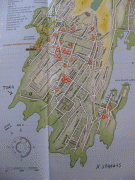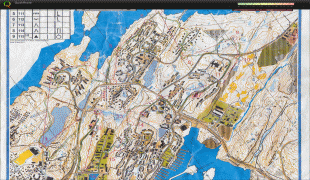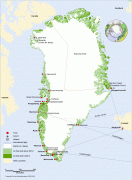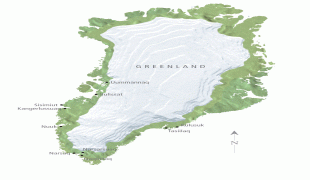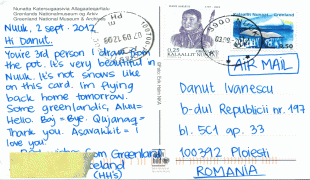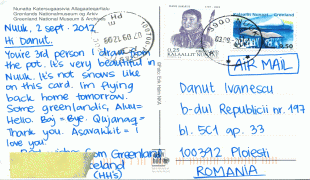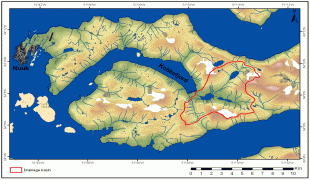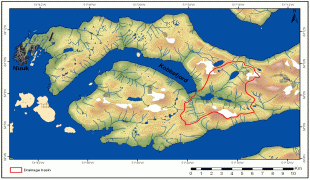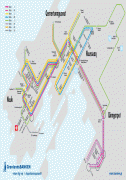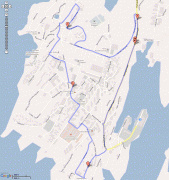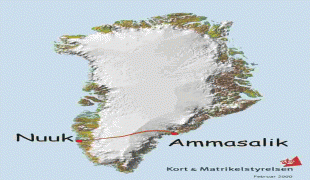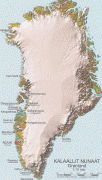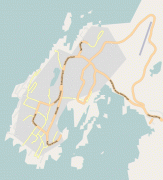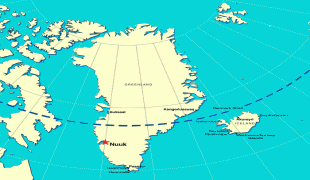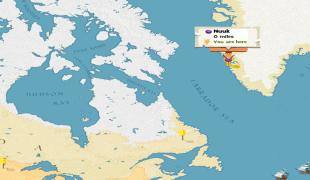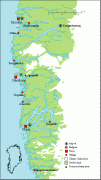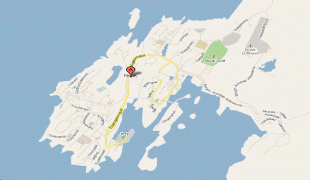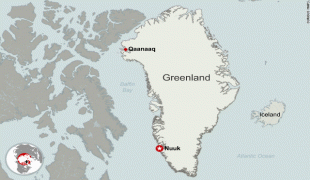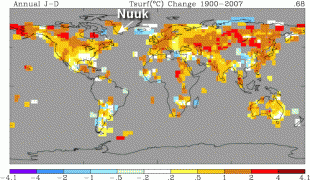Nuuk
 |
The city was founded in 1728 by the Dano-Norwegian missionary Hans Egede when he relocated from the earlier Hope Colony (Haabets Koloni) where he arrived in 1721. The governor Claus Paarss was part of the relocation. The new colony was placed at the Inuit settlement of Nûk and was named Godthaab ("Good Hope"). "Nuuk" is the Greenlandic word for "cape" (næs) and is commonly found in Greenlandic place names. It is so named because of its position at the end of the Nuup Kangerlua fjord on the eastern shore of the Labrador Sea. Its latitude, at 64°11' N, makes it the world's northernmost capital, only a few kilometres farther north than the Icelandic capital Reykjavík. When home rule was established in 1979, the authorization of place names was transferred to Greenlandic authorities, who subsequently preferred Greenlandic names over Danish ones. The name Godthåb mostly went out of use over the next two decades.
The campus of the University of Greenland, hosting Statistics Greenland and the main holdings of the Public and National Library of Greenland, are at the northern end of the district, near the road to Nuuk Airport.
Nuuk receives its electric power mainly from the renewable energy-powered Buksefjord hydroelectric power plant by way of a 132 kV powerline crossing Ameralik fjord over a distance of 5376 m, the world's longest free span.
The site has a long history of habitation. The area around Nuuk was first occupied by the ancient, pre-Inuit, Paleo-Eskimo people of the Saqqaq culture as far back as 2200 BC when they lived in the area around the now abandoned settlement of Qoornoq. For a long time, it was occupied by the Dorset culture around the former settlement of Kangeq, but they disappeared from the Nuuk district before AD 1000. The Nuuk area was later inhabited by Viking explorers in the 10th century (Western Settlement), and shortly thereafter by Inuit peoples. Inuit and Norsemen both lived with little interaction in this area from about 1000 until the disappearance of the Norse settlement for uncertain reasons during the 15th century.
The city proper was founded as the fort of Godt-Haab in 1728 by the royal governor Claus Paarss, when he relocated the missionary and merchant Hans Egede's earlier Hope Colony (Haabets Koloni) from Kangeq Island to the mainland. At that time, Greenland was formally still a Norwegian colony (until 1814) under the united Dano-Norwegian Crown, but the colony had not had any contact for over three centuries. Paarss's colonists consisted of mutinous soldiers, convicts, and prostitutes and most died within the first year of scurvy and other ailments. In 1733 and 1734, a smallpox epidemic killed most of the native population as well as Egede's wife. Hans Egede went back to Denmark in 1736 after 15 years in Greenland, leaving his son Poul to continue his work. Godthaab became the seat of government for the Danish colony of South Greenland, while Godhavn (modern Qeqertarsuaq) was the capital of North Greenland until 1940, when the administration was unified in Godthaab.
In 1733, Moravian missionaries received permission to begin a mission on the island; in 1747, there were enough converts to prompt the construction of the Moravian Brethren Mission House and the formal establishment of the mission as New Herrnhut (Nye-Hernhut). This became the nucleus for present-day Nuuk as many Greenlanders from the southeastern coast left their territory to live at the mission station. From this base, further missions were established at Lichtenfels (1748), Lichtenau (1774), Friedrichsthal (1824), Umanak (1861), and Idlorpait (1864), before they were discontinued in 1900 and folded into the Lutheran Church of Denmark.
Around 1850, Greenland, and especially the area around Nuuk, were in crisis. The Europeans had brought diseases and a culture that conflicted with the ways of the native Greenlanders. Many Greenlanders were living in poverty. In 1853, Hinrich Johannes Rink came to Greenland and was surprised at how local Greenlandic culture and identity had been suppressed under Danish influence. In response, in 1861, he started the Atuagagdliutt, Greenland's first newspaper, with a native Greenlander as editor. This newspaper based in Nuuk later became an important token of Greenlandic identity.
During World War II, there was a reawakening of Greenlandic national identity. The use of written Greenlandic grew, a council was assembled under Eske Brun's leadership in Nuuk. In 1940, an American and a Canadian Consulate were established in Nuuk.
Under new regulations in 1950, two councils amalgamated into one. This Countryside Council was abolished on 1 May 1979, when the city of Godthåb was renamed Nuuk by the Greenland Home Rule government. The city boomed during the 1950s when Denmark began to modernize Greenland. As in Greenland as a whole, Nuuk is populated today by both Inuit and Danes. Over a third of Greenland's total population lives in the Nuuk Greater Metropolitan area.
Map - Nuuk
Map
Country - Greenland
 |
 |
Though a part of the continent of North America, Greenland has been politically and culturally associated with Europe (specifically Norway and Denmark, the colonial powers) for more than a millennium, beginning in 986. Greenland has been inhabited at intervals over at least the last 4,500 years by Arctic peoples whose forebears migrated there from what is now Canada. Norsemen settled the uninhabited southern part of Greenland beginning in the 10th century, having previously settled Iceland. Inuit arrived in the 13th century. Though under continuous influence of Norway and Norwegians, Greenland was not formally under the Norwegian crown until 1261. The Norse colonies disappeared in the late 15th century, after Norway was hit by the Black Death and entered a severe decline.
Currency / Language
| ISO | Currency | Symbol | Significant figures |
|---|---|---|---|
| DKK | Danish krone | kr | 2 |
| ISO | Language |
|---|---|
| DA | Danish language |
| EN | English language |
| KL | Greenlandic language |






